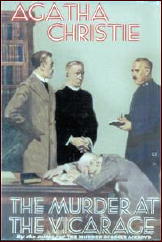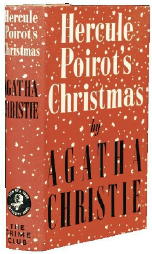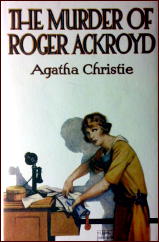Tue 24 Jun 2014
A SHORT NOTE ON AGATHA CHRISTIE’S PROFESSIONALISM, by Josef Hoffmann
Posted by Steve under Authors[6] Comments
by Josef Hoffmann
The sociologist Pierre Bourdieu claimed that a literary field began to form in 19th century society that followed specific rules. These rules had to be obeyed by a writer if he wanted his literary products to be successful. Indeed, he almost had to internalise them.
For example, an author of fiction must not directly express his political or philosophical views, as an author of factual books might, but must instead translate them into the narrative of a novel, integrated into the plot or the dialogues of the protagonists, in order to comply with the rules of novel-writing. Yet the rules of the literary field are not rigid, but are adaptable to some degree, thus allowing scope for experimentation.
It is my theory that, at the time when Agatha Christie began to write her detective novels, a relatively independent literary field began to develop – the genre of the detective story – with its own specific rules. This was expressed in the discourse of the time on the rules of fair play between author and reader and the foundation of the Detection Club, which obliged its members to comply with certain rules.
Agatha Christie was so successful because she mastered the rules of the genre (which were not as narrowly defined as those of the Detection Club), rules that became second nature to her.
This becomes clear, for example, in her Miss Marple novel, The Murder at the Vicarage (1930). Almost at the beginning of the detective novel, Christie writes that the life of the parish seems to have been created for the amusement of the vicar’s young wife, and that her regular afternoon teas served the purpose of exchanging gossip. Towards the end of the novel, the vicar gives a sermon which, rather than being shaped by the Christian spirit, foams with dramatic rhetoric in order to impress the congregation.
Despite this interweaving of criticism of the church, it would never have occurred to Christie to call her novel something like “The Church Is Dead.†Instead she chose a suitable title for a detective novel, The Murder at the Vicarage, which itself is actually outrageous, as the vicarage, the centre of the Christian parish, should be a place of devotion and the love of one’s fellow man, and not the scene of a murder.
But this is accepted by the reader, whereas a title explicitly critical of the church would have met with rejection. In Hercule Poirot’s Christmas (1938), there is a murder during this festive season, despite the fact that, in the opinion of one protagonist, Christmas should be a celebration of peace and reconciliation.
But Hercule Poirot calls Christmas a time of hypocrisy. Yet the title of the detective novel is not “A Celebration of Hypocrisy,†which would certainly have damaged the sales of the book.
In his history of crime literature, Julian Symons finds fault with the fact that the General Strike of 1926 never took place in British detective stories of the Golden Age. But that is not quite right. Christie included the element of the General Strike in the narrative structure of the novel The Murder of Roger Ackroyd, from 1926. By making the narrator and assistant to the detective a murderer, she suspended the rules of fair play, quite in the manner of a general strike.
The scope of Agatha Christie’s knowledge was broader than some literary critics would like to believe.
Further Reading:
Pierre Bourdieu: The Rules of Art: Genesis and Structure of the Literary Field, Polity Press 1996
John Curran: Agatha Christie’s Secret Notebooks, Harper 2011
Curtis Evans: Was Corinne’s Murder Clued?: The Detection Club and Fair Play, 1930-1953, CADS Supplement Number 14
Howard Haycraft (ed.): The Art of the Mystery Story, Carroll & Graf 1992 (Part 2: The Rules of the Game)
Julian Symons: Bloody Murder: From the Detective Story to the Crime Novel: a History, Papermac 1992.
— Translated by Carolyn Kelly



June 24th, 2014 at 6:43 pm
I enjoy this sort of meta text look at favorite writers, but the Ackroyd General Strike hypothesis is a stretch even by meta text standards.
On the other hand Christie was not a conservative lady whatever her politics. She famously divorced, and may well have tried to frame her then husband for murder, and you will notice more often than not in her books if there are lovers they are up to something wrong unless they are the protagonists, and even then they tend to be rather dry relationships. She has little interest in romance.
She seems to have had a jaundiced view of much of British society. She isn’t particularly enamored of doctors, vicars, policemen, judges, or most of the military. While she is far from liberal or radical, Miss Marple’s general attitude wouldn’t be out of place in a hard boiled private eye, and for an ex policeman, Poirot has little use for the law.
Ten Little Indians, the book, doesn’t even have a protagonist though there is a detective.
There is nothing cozy or truly quaint in Christie, she seems to be willing to be, if not a social critic, at least a gadfly biting the pompous, smug, and self satisfied with real zeal. Almost everyone underestimates or laughs at Poirot and Miss Marple to their regret. Her Harly Quinn stories are perhaps the most reveling since Quinn neither terribly compassionate or kind, but more often the relentless harbinger of fate.
She certainly doesn’t seem to have been a great respecter of authority, tradition, or the status quo. The reason she remains highly readable isn’t merely her plots, but the fact she is a better writer and a more interesting one than we often credit her with being.
June 25th, 2014 at 1:10 am
A lot of the ‘Aren’t the books just so sweet?’ attitude came about in the 70s, when the first really big film adaptions came to be made. Enjoyable though they are, the Finney/Ustinov Poirots do take place in a sort of theme park 30s. They’ve become nostalgic only because the passage of time has simplified them. The books often make obvious or oblique comment on the era that they were written. THE SECRET ADVERSARY has the demobbed heroes still scurrying around looking for a place in the world, and the General Strike is actually anticipated, A post-war book like MRS MCGINTY’S DEAD has a subtext of the break up of Empire, the Summerhayes family who are returning to a Britain that they don’t really fit into.
Christie was always something of a natural outsider, and this is one of the things that has kept the books fresh.
June 25th, 2014 at 12:37 pm
That is a good theory of yours, that the nostalgia factor for Christie’s work came about around the same time as the movie versions of the books, beginning in the 1970s. Anyone who has read the books themselves know for a fact that Christie was not and is not a “cozy” writer, and she could sum up of her characters completely in only a sentence or two. Many of them were not nice people at all, and almost all had their flaws, which she could pinpoint to within a millimeter or two.
June 25th, 2014 at 12:55 pm
My daughter is named Christie for obvious reasons. My favorite novel may be Ten Little Indians and I’ve seen the 1945 film a dozen times. It was constantly on TV back in the 1950’s and 1960’s.
June 25th, 2014 at 3:57 pm
The beauty of And Then There Were None is derived from the witty and romantic screenplay, Dudley Nichols, charming cast, and Rene Clair’s superb visual complements. I do not believe Christie had any significant social observations to make. She was bourgeois, living in a world of doctors, lawyers and minor politicians. It would have been a near impossibility to make the postman an object of desire, victim or perpetrator.
June 25th, 2014 at 8:56 pm
I agree on the nostalgia theory, and would never suggest Christie as a social reformer, but while she was a woman of her time and class she is far from typical in her portrayal of England and the English, and in general much kinder to the outsider than the typical writer of her era. There is precious little of Sayers anti-Semitism and forelock tugging or resentful brutal peasants, and characters that at first seem to be humorous foreigners often turn out to be much more in Christie where in Sayers they will most likely turn out to be oily and distrust worthy. In Sayer’s world an artist is likely to prove a slippery character, but in Christie’s a slippery character may prove one of the few people in the book worthy of some admiration. She is virtually the only major writer of the era who portrays the lower middle class as anything but a joke.
We are clearly meant to smile at Poirot and his Belgian vanity and at Miss Marple’s incongruity, but always at the end of the book they show themselves to be the most decent people in the book and like Father Brown can rise to real power as they sum up the crime and the motives of even the most innocent suspects.
In fact no one is fully innocent in Christie’s world and her detectives are cynical and wise to that when everyone else is blind. Captain Hastings isn’t merely Watson nor Japp Lestrade. Both are her rather sharp tongued observations of types common in her world, and whatever good qualities they have she doesn’t mind suggesting their blindness does harm in a way Doyle never suggests Watson does because they only see what they expect based on their prejudices.
She is certainly middle class and bourgeois, but she has no desire to marry her sleuth like Sayers or make him an ultimately romantic figure like the royal blooded Campion. Those Quinn stories show a side of her hidden a bit better in the other series and novels. Wimsey, Campion (for the most part), Alleyn, and Appleby restore order, Poirot, Quinn, and Marple are avengers, never really happy just solving the puzzle or restoring the status quo.
I think the social comment is a byproduct, and far from the purpose of the novels, but it is there because in Christie no one is ever just innocent, few lovers pass without an agenda — often murderous, and the greatest skill of Poirot and Miss Marple is their ability to see through appearances.
The real genius of Ackroyd for instance isn’t that Watson did it, or that she violated the rules, because she did not. If you read the book carefully you can spot the same clues Poirot does, and a few the reader alone has access to. It’s certainly more fair than Van Dine where to solve the crime you need to know the properties of heavy water or higher math. Unlike the Van Dine school many of Christie’s crimes could easily have occurred in the real world — at least the method and motive if not the act itself.
And clever as her plotting is she does make mistakes, such as not bothering to find out ventriloquism only works if you are looking at the ventriloquists face.